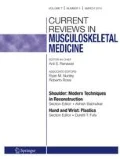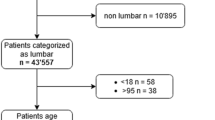Abstract
Predictive analytic algorithms are designed to identify patterns in the data that allow for accurate predictions without the need for a hypothesis. Therefore, predictive modeling can provide detailed and patient-specific information that can be readily applied when discussing the risks of surgery with a patient. There are few studies using predictive modeling techniques in the adult spine surgery literature. These types of studies represent the beginning of the use of predictive analytics in spine surgery outcomes. We will discuss the advancements in the field of spine surgery with respect to predictive analytics, the controversies surrounding the technique, and the future directions.
Similar content being viewed by others
References
Papers of particular interest, published recently, have been highlighted as: • Of importance
Bridwell KH, Baldus C, Berven S, Edwards 2nd C, Glassman S, Hamill C, et al. Changes in radiographic and clinical outcomes with primary treatment adult spinal deformity surgeries from two years to three- to five-years follow-up. Spine. 2010;35:1849–54.
Bridwell KH, Glassman S, Horton W, Shaffrey C, Schwab F, Zebala LP, et al. Does treatment (nonoperative and operative) improve the two-year quality of life in patients with adult symptomatic lumbar scoliosis: a prospective multicenter evidence-based medicine study. Spine. 2009;34:2171–8.
Liu S, Schwab F, Smith JS, Klineberg E, Ames CP, Mundis G, et al. Likelihood of reaching minimal clinically important difference in adult spinal deformity: a comparison of operative and nonoperative treatment. Ochsner J. 2014;14:67–77.
Scheer JK, Smith JS, Clark AJ, Lafage V, Kim HJ, Rolston JD, et al. Comprehensive study of back and leg pain improvements after adult spinal deformity surgery: analysis of 421 patients with 2-year follow-up and of the impact of the surgery on treatment satisfaction. J Neurosurg Spine. 2015;22:540–53.
Smith JS, Shaffrey CI, Glassman SD, Carreon LY, Schwab FJ, Lafage V, et al. Clinical and radiographic parameters that distinguish between the best and worst outcomes of scoliosis surgery for adults. Eur Spine J. 2013;22:402–10.
Weiss HR, Goodall D. Rate of complications in scoliosis surgery—a systematic review of the Pub Med literature. Scoliosis. 2008;3:9.
Yadla S, Maltenfort MG, Ratliff JK, Harrop JS. Adult scoliosis surgery outcomes: a systematic review. Neurosurg Focus. 2010;28:E3.
Charosky S, Guigui P, Blamoutier A, Roussouly P, Chopin D, Study Group on S. Complications and risk factors of primary adult scoliosis surgery: a multicenter study of 306 patients. Spine. 2012;37:693–700.
Cho SK, Bridwell KH, Lenke LG, Cho W, Zebala LP, Pahys JM, et al. Comparative analysis of clinical outcome and complications in primary versus revision adult scoliosis surgery. Spine. 2012;37:393–401.
Daubs MD, Lenke LG, Cheh G, Stobbs G, Bridwell KH. Adult spinal deformity surgery: complications and outcomes in patients over age 60. Spine. 2007;32:2238–44.
DeWald CJ, Stanley T. Instrumentation-related complications of multilevel fusions for adult spinal deformity patients over age 65: surgical considerations and treatment options in patients with poor bone quality. Spine. 2006;31:S144–51.
Bridwell KH, Lewis SJ, Edwards C, Lenke LG, Iffrig TM, Berra A, et al. Complications and outcomes of pedicle subtraction osteotomies for fixed sagittal imbalance. Spine. 2003;28:2093–101.
Acosta Jr FL, McClendon Jr J, O’Shaughnessy BA, Koller H, Neal CJ, Meier O, et al. Morbidity and mortality after spinal deformity surgery in patients 75 years and older: complications and predictive factors. J Neurosurg Spine. 2011;15:667–74.
Zhang HQ, Huang J, Guo CF, Liu SH, Tang MX. Two-level pedicle subtraction osteotomy for severe thoracolumbar kyphotic deformity in ankylosing spondylitis. Eur Spine J. 2014;23:234–41.
Abbott D: Applied predictive analytics: principles and techniques for the professional data analyst. 2014.
Daubs MD, Hung M, Adams JR, Patel AA, Lawrence BD, Neese AM, et al. Clinical predictors of psychological distress in patients presenting for evaluation of a spinal disorder. Spine J. 2014;14:1978–83. The first to use a modern predictive model using decision trees to enhance predictability in spine surgery patients.
Abbott D. Applied predictive analytics: principles and techniques for the professional data analyst. Indianapolis: Wiley; 2014.
Chen HN, Tsai YF. A predictive model for disability in patients with lumbar disc herniation. J Orthop Sci. 2013;18:220–9.
Ialenti MN, Lonner BS, Verma K, Dean L, Valdevit A, Errico T. Predicting operative blood loss during spinal fusion for adolescent idiopathic scoliosis. J Pediatr Orthop. 2013;33:372–6.
Lee MJ, Cizik AM, Hamilton D, Chapman JR. Predicting medical complications after spine surgery: a validated model using a prospective surgical registry. Spine J. 2014;14:291–9. An early publication in predicting outcomes as a tool for preoperative patient counseling, shared surgical decision making, improving safety in spine surgery, and overall for risk stratification.
Mathai KM, Kang JD, Donaldson WF, Lee JY, Buffington CW. Prediction of blood loss during surgery on the lumbar spine with the patient supported prone on the Jackson table. Spine J. 2012;12:1103–10.
Tetreault LA, Kopjar B, Vaccaro A, Yoon ST, Arnold PM, Massicotte EM, et al. A clinical prediction model to determine outcomes in patients with cervical spondylotic myelopathy undergoing surgical treatment: data from the prospective, multi-center AOSpine North America study. J Bone Joint Surg Am. 2013;95:1659–66.
Azimi P, Mohammadi HR, Benzel EC, Shahzadi S, Azhari S, Montazeri A. Artificial neural networks in neurosurgery. J Neurol Neurosurg Psychiatry. 2015;86:251–6.
Spratt KF, Keller TS, Szpalski M, Vandeputte K, Gunzburg R. A predictive model for outcome after conservative decompression surgery for lumbar spinal stenosis. Eur Spine J. 2004;13:14–21.
Azimi P, Benzel EC, Shahzadi S, Azhari S, Mohammadi HR. Use of artificial neural networks to predict surgical satisfaction in patients with lumbar spinal canal stenosis: clinical article. J Neurosurg Spine. 2014;20:300–5.
Scheer JK, Osorio JA, Smith JS, Schwab F, Lafage V, Hart RA, et al. Development of validated computer-based pre-operative predictive model for proximal junction failure (PJF) or clinically significant PJK with 86% accuracy based on 510 ASD patients with 2-year follow-up. Spine. 2016. A modern predictive model used to identify surgical complications in the adult spinal deformity patient.
Author information
Authors and Affiliations
Corresponding author
Ethics declarations
Conflict of interest
Joseph A. Osorio and Justin K. Scheer declare that they have no conflict of interest.
Christopher P. Ames reports consultancy fees from Stryker, Medtronic, and DePuy. He also reports royalties from Biomet Spine and Stryker, as well as employment with UCSF, outside of the submitted work. Dr. Ames has a patent issued with Fish & Richardson, P.C.
Human and animal rights and informed consent
This article does not contain any studies with human or animal subjects performed by any of the authors.
Additional information
This article is part of the Topical Collection on Complications in Spine Surgery
Rights and permissions
About this article
Cite this article
Osorio, J.A., Scheer, J.K. & Ames, C.P. Predictive modeling of complications. Curr Rev Musculoskelet Med 9, 333–337 (2016). https://doi.org/10.1007/s12178-016-9354-7
Published:
Issue Date:
DOI: https://doi.org/10.1007/s12178-016-9354-7




